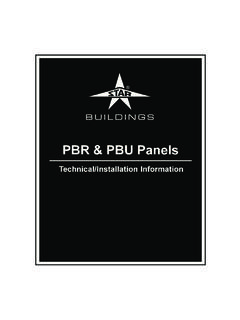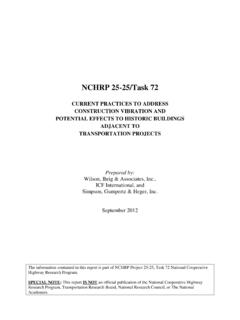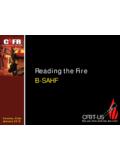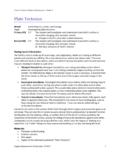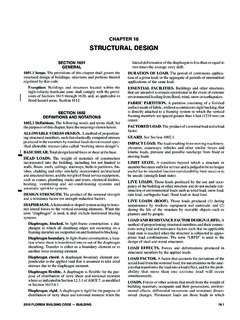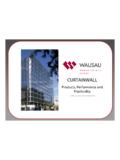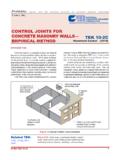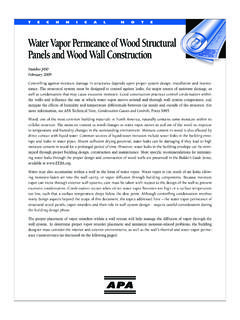Transcription of Technical Installation Information
1 Technical Installation Information IMPORTANT NOTICE. READ THIS MANUAL COMPLETELY PRIOR TO BEGINNING THE Installation OF THE Double-Lok . ROOFING SYSTEM. ALWAYS INSPECT EACH AND EVERY PANEL AND ALL ACCESSORIES BEFORE Installation . NEVER INSTALL ANY PRODUCT IF ITS QUALITY IS IN QUESTION. NOTIFY MBCI IMMEDIATELY IF ANY. PRODUCT IS BELIEVED TO BE OUT OF TOLERANCE, SPECIFICATION OR HAS BEEN DAMAGED. DURING SHIPMENT. IF THERE IS A CONFLICT BETWEEN PROJECT ERECTION DRAWINGS PROVIDED OR APPROVED BY. THE MANUFACTURER AND DETAILS IN THIS MANUAL, PROJECT ERECTION DRAWINGS WILL TAKE. PRECEDENCE. Ice Dam Disclaimer MBCI designs its standing seam roofs to meet the load requirements dictated by governing codes and project specifications, including applicable snow loads. However, NCI expressly disclaims responsibilty for weathertightness or roof point loading issues or other hazards resulting from ice dam situations. Any time ice and snow can melt on the main body of the roof and refreeze at the eave or in the shadow of an adjacent wall, an ice dam situation may develop.
2 In addition to local climate, ice dam formation is affected by many other factors, including but not limited to, roof insulation R. value, roof panel color, interior temperature of building, heater location in building, eave overhangs, parapet walls, shading of building roof areas from adjacent trees, parapets, buildings, etc. These factors are design and maintenance issues and are outside the control of NCI. NCI specifically disclaims any liability for damage due to ice dam formation, although the following issues should be taken into consideration concerning standing seam roofs installed in freezing climates: Always use field seamed panels. These machine-folded seams are more durable when subjected to occasional icing. Eliminate "cold" eave overhangs and parapet walls from the building design. Roof overhangs outside the heated envelope of the building will tend to be colder than the roof areas over the heated envelope. Simple roof designs are preferred.
3 Parapet walls at the eave allow ice and snow to collect due to shading effects and the lower roof temperatures caused thereby. Make sure the interior of the building is adequately insulated and the heating is properly distributed. Inadequate insulation in the roof and/or improper heat distribution causes heat flow though the main body of the roof. On days when the temperature is below freezing, this heat gain can cause ice and snow to melt and refreeze at the eave where the roof is colder. Lay out the building to prevent the eaves and other roof areas from being shaded during the winter. This may mean eliminating adjacent trees or reconsidering roof geometries. Consider using self-regulating heating cables at the eaves to mitigate the effects of ice dams. On building designs using attics, over-insulate the attic floor and provide adequate ventilation in the attic. This will reduce heat transfer through the roof resulting in more consistent roof temperatures between eave and field of roof.
4 Increase the degree of diligence with respect to underlayment materials at roof areas prone to icing. This may include valleys, eaves, dormers and roof areas near dormers, parapets and the like where shading may occur. For more Information on this subject, please refer to the MCA's Metal Roof Design For Cold Climates manual. The Engineering data contained herein is for the expressed use of customers and design professionals. Along with this data, it is recommended that the design professional have a copy of the most current version of the North American Specification for the Design of Cold-Formed Steel Structural Members published by the American Iron and Steel Institute to facilitate design. This Specification contains the design criteria for cold-formed steel components. Along with the Specification, the designer should reference the most current building code applicable to the project jobsite in order to determine environmental loads. If further Information or guidance regarding cold-formed design practices is desired, please contact the manufacturer.
5 Copyright NCI Group, Inc. 2012 All Rights Reserved. 02-12. Descriptions and specifications contained herein were in effect at the time this publication was approved for printing. In a continuing effort to refine and improve products, MBCI reserves the right to discontinue products at any time or change specifications and/or designs without incurring obligation. To ensure you have the latest Information available, please inquire or visit our website at Application details are for illustration purposes only and may not be appropriate for all environmental conditions, building designs, or panel profiles. Projects should be engineered to conform to applicable building codes, regulations, and accepted industry practices. Insulation is not shown in these details for clarity. Houston, TX 877-713-6224 Jackson, MS 800-622-4136 Phoenix, AZ 888-533-6224. Adel, GA 888-446-6224 Lubbock, TX 800-758-6224 Richmond, VA 800-729-6224. Atlanta, GA 877-512-6224 Memphis, TN 800-206-6224 Rome, NY 800-559-6224.
6 Atwater, CA 800-829-9324 Oklahoma City, OK 800-597-6224 Salt Lake City, UT 800-874-2404. Dallas, TX 800-653-6224 Omaha, NE 800-458-6224 San Antonio, TX 800-598-6224. Indianapolis, IN 800-735-6224. TABLE OF CONTENTS. ROOFING SYSTEM. Features And Benefits ..DL-2. ENGINEERING. Read This First ..DL-3. UL 90 Construction Numbers ..DL-4. Factory Mutual Approval ..DL-4. ICBO Approval/Florida Building Code Product Approval ..DL-4. 24" Section Properties/Load Tables ..DL-5-6. 18" Section Properties/Load Tables ..DL-7-8. 12" Section Properties/Load Tables ..DL-9-10. SPECIFICATIONS. Specifications For Metal Roofing ..DL-11-16. GENERAL Information . General Description ..DL-17. Product Checklist ..DL-18-26. Preparatory Requirements ..DL-27. Unloading ..DL-28. Handling & Panel Storage ..DL-29. ERECTION SEQUENCE. Step 1 Rake Support ..DL-30. Step 2 Low System Eave ..DL-31. Step 2A Low System Eave/Metal Inside Closure ..DL-32. Step 2B High System Eave ..DL-33. Step 2C High System Eave/Metal Inside Closure.
7 DL-34. Step 3 Thermal Spacer (for high systems only) ..DL-35. Step 4 First Panel ..DL-36-37. Step 5 Back-Up Plate ..DL-38. Step 6 Clip Installation ..DL-39. Step 7 Endlap Panel ..DL-40. Step 8 Standard Endlap ..DL-41. Step 9 Ridge Panel ..DL-42. Step 10 Subsequent Runs Eave ..DL-43. Step 11 Subsequent Runs Endlap ..DL-44. Step 12 Subsequent Runs Ridge/Outside Closure ..DL-45. Step 13 Seaming Panel Sidelaps ..DL-46-47. Step 14 Last Panel Run ..DL-49. Step 14A Last Panel Run (Optional) ..DL-50. Step 15 Outside Closure ..DL-51. Step 16 Ridge Outside Closure/Flashing ..DL-52. SPECIAL ERECTION TECHNIQUES. Recommended Erection Practices ..DL-53-55. Light Transmitting Panel Trim Installation (Optional) ..DL-56. Field Located LTP Installation ..DL-57-61. Ridge Ventilator ..DL-52-64. Vented Ridge ..DL-65. Mid Slope Fixed Condition ..DL-66. Roof Curb Installation ..DL-67-72. Pipe Penetration Installation ..DL-73-74. Repair Cap On Damaged Double-Lok Seams ..DL-75.
8 S-5! Double-Lok Wind Clamps ..DL-76. DESIGN. Trim Details Eave To Endlap ..DL-77. Ridge ..DL-78. Floating Peak Box ..DL-79. Rake ..DL-80. Rake To Rake ..DL-81. Rake Parapet ..DL-82. High Eave Parapet ..DL-83. Eave ..DL-84. Snow Gutter ..DL-85. Hip ..DL-86. Valley ..DL-87. GENERAL Information . Proper Handling, Storage and Maintenance ..DL-88-89. EFFECTIVE FEBRUARY 15, 2012 SEE FOR CURRENT Information SUBJECT TO CHANGE WITHOUT NOTICE DL-1. Houston, TX 877-713-6224 Jackson, MS 800-622-4136 Phoenix, AZ 888-533-6224. Adel, GA 888-446-6224 Lubbock, TX 800-758-6224 Richmond, VA 800-729-6224. Atlanta, GA 877-512-6224 Memphis, TN 800-206-6224 Rome, NY 800-559-6224. Atwater, CA 800-829-9324 Oklahoma City, OK 800-597-6224 Salt Lake City, UT 800-874-2404. Dallas, TX 800-653-6224 Omaha, NE 800-458-6224 San Antonio, TX 800-598-6224. Indianapolis, IN 800-735-6224. ROOFING SYSTEM. FEATURES AND BENEFITS. 1. DESIGN INTEGRITY. MBCI's Double-Lok mechanically seamed system begins and ends in the high, reducing the risk of leakage at the rake that can occur when finishing in the low.
9 The panel seam includes factory-applied mastic. 2. FLOATING ROOF. The Double-Lok roof was designed to cope with the forces of expansion and contraction. This is accomplished by allowing the panels to freely move up and down the roof slope. 3. SLIDING CLIPS. 2" and 4" Sliding Clips are available, with the 2" version providing 1-1/4" moverment in each direction while the 4". version provides for 2" of movement in each direction. Both clips are also available in high and low versions, which provides a 3/8" clearance or a 1-3/8" clearance, allowing for a variety of thermal spacer and insulation thickness combinations. 4. UL 90 RATING. The Double-Lok roof system has 7 different UL 90 construction numbers, each of which is available with several options. 5. FACTORY MUTUAL APPROVAL. The Double-Lok roof has been tested by Factory Mutual Research Corporation for wind uplift, fire and hail damage under Standard 4471 achieving various ratings. Refer to page DL-4 for summary Information .
10 6. FIRE RESISTANCE RATINGS. The roof system qualifies for use in several UL design assemblies and carries a UL Class A Fire Rating. 7. SIMPLICITY. No troublesome batten cap is needed. The panels simply seam together forming a watertight seal. 8. FLEXIBILITY. MBCI's Double-Lok roof system offers welcome flexibility to the erector. Wall covering can be erected before or after the roof is installed. Panel Installation is an uninterrupted procedure. 9. EASE OF Installation . The erector has the option to sheet each side of the roof separately or both sides simultaneously, which greatly increases the speed and convenience of erection. Being reversible end-for-end, sheets do not have to be special ordered for each side of the building. No field notching of panels at endlaps or ridge is required. 10. FORGIVING SYSTEM. The Double-Lok design allows for the roof to be finished in the high when an out-of-square condition or other factors cause the roof to terminate up to 4" out of module.



